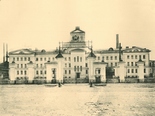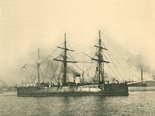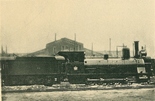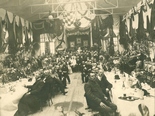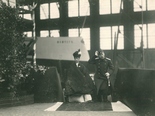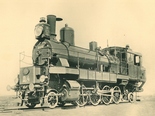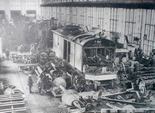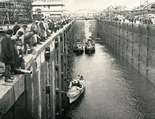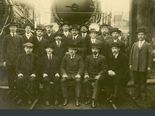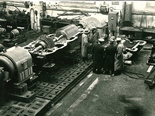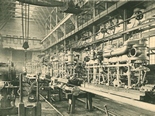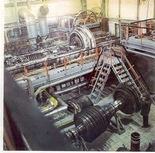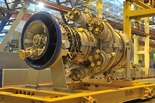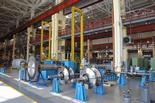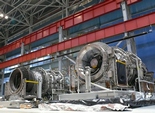
CJSC ''Nevskiy Zavod''
Nevskiy Zavod is one of the oldest industrial enterprises
of St. Petersburg, a leading power-engineering
enterprise of Russia.
Nevskiy Zavod has a rich industrial history. It was founded in 1857 as a shipbuilding plant and it has produced more than 200 warships. At the turn of 19-20th centuries, when Russia started to develop rapidly railway construction, the Plant mastered production of steam locomotives, and produced more than 4000 units. In the 20-ies the plant was involved in the GOELRO plan and changed its profile to power machine-building, and in the 30 's declared itself as the producer of the first Russian centrifugal turbo-machine for air supply into the blast furnace. A new stage in the development of the Plant began, new sophisticated machines were mastered at a fast pace: compressors, gas blowers, turbines, steam boilers. The plant had produced about 100 machines of 19 types by 1941.
In 1949 the first gas turbine was built in the Soviet Union, and in 1958 production of gas turbines and gas-pumping units for gas pipelines has started. This determined the basic profile of the plant activity in the coming years.
In 1857, Major General Pyotr Semyannikov and Lieutenant Colonel Vasily Poletika bought the small ironworks of an Englishman named Thomson that was situated on a bank of the Neva River.
At the end of the 19th century the naval fleet’s wooden ships began to be replaced. Semyannikov and Poletika were among the first to receive a commission from the Department of the Navy for building ships.
A massive restructuring began; the old workshops were remodeled, and new workshops sprung up.
A mere year after the founding of the factory, two small steamers, the "Maria" and the "Workman" were launched, and 8 years later in 1865, the first ironclad battleship produced domestically, the "Kremlin", emerged down the launch slipway.
The development of the railway building sector of industry in Russia led to the need to rapidly increase the amount of available rolling stock. In March of 1867, the government announced a competition for the best locomotive manufactured in a domestic plant.In 1869, the first locomotive was built in Nevsky Zavod, which in 1870 was recognized as best entrant in the All-Russian Industrial Exhibition. The plant was awarded the Lesser Coat of Arms of the Russian Empire. This coat of arms subsequently crowned the main gate of the plant, in front of the factory’s administrative building.
Steam-locomotive building required huge investments, therefore in 1870 established was a joint-stock company "Russian Society of Mechanical and Mining Plants”. The territory of the old manufacturing plant was increased. New shops emerged, a connecting path with the Nikolayevskaya railway was built. By 1882, the 1,000th locomotive had already been produced.
In 1891, the plant was acquired by the engineer and industrialist, Valeriyan Titov, and the Joint Stock Corporation, the Moscow Partnership of the Nevsky Shipbuilding and Mechanical Plant, was founded. Among the founders was a major railway luminary of the day, Savva Mamontov, who was known by both industrialists, as well as the cultural intelligentsia. Among the many guests who visited his house were Repin, Chaliapin, Vrubel, and many others.
В 1898 году In 1898, the National Bank bought the majority of the shares of the plant, which from then became known as the Nevsky Shipbuilding and Engineering Plant. Orders formerly placed abroad, were transferred to Nevsky Zavod.
Likewise, an order for two cruisers was received, the "Emerald", and the "Pearl", the launch of the latter being attended by Nicholas II himself, along with his wife and entourage.
В июле 1910 г. In July 1910, the three thousandth locomotive was built, timed to coincide with the fiftieth anniversary of the beginning of the plant’s production of large-scale industrial orders.
Prior to 1917, the plant turned out more than 4 thousand locomotives and 174 ships of various purposes.
In 1918, Nevsky Zavod was nationalized and changed its business profile to power plant engineering.
In the 1920s, the plant became actively involved in the implementation of the state plan for the electrification of the country, and in 1921 received an order for the production of the caissons and sluice-gates for the first hydroelectric station, built in the town of Volkhov.
In 1922, at the initiative of the plant’s workers, the factory was bestowed with the name of Vladimir Lenin.
In the 30's, during the industrialization of the country, Nevsky Zavod became the first producer in Russia to manufacture a centrifugal turbine for the supplying of air to blast furnaces. The plant got into the swing if things at a very rapid rate, with complex new machinery like compressors, blowers, exhaust ventilators, turbines, and steam boilers.
The era of turbine manufacture had begun.
In 1933, they produced the first Russian exhaust draft fans, and in 1935, the first steam turbine was manufactured.
Prior to 1941, more than 130 compressors of 20 different types were produced in Nevsky Zavod.
During the years of the Second World War, the factory never stopped working - manufacturing parts for aerial bombs, establishing the mass production of artillery shells, and repairing the tanks which drove out of the factory gates, straight to the frontlines.
After the breaking of the blockade of Leningrad, Nevsky Zavod received the first orders for peacetime production.
In 1945, the design engineers of Nevsky Zavod started developing a gas turbine power plant, which was already placed into production by 1947.
In 1952 the first domestically produced stationary gas turbine was built, the GT-600, with a power output of 1.5 MW (megawatts), and by 1956, six of the industrial gas turbines had already been manufactured.
In 1958, their first natural gas compressor, the N-280, was manufactured, and production of gas turbines and gas-compressor units for gas main pipelines began. This has remained the basic business profile of the plant to the present day.
In 1968, mass production commenced of the largest gas-pumping plants in the USSR, the GTC-10, with a power output of 10 MW (megawatts).
In 1974, the Scientific Design and Research Technological Institute of Turbo Compressor Manufacturing was established in Nevsky Zavod. It created a complete range of new machinery (instead of imported ones) that was designed and built as the most powerful in the USSR: the gas-compressor unit, the GTC-25, the increased capacity GTC-10, and later, the new GPC GTNR-16, with a power capacity of 16 MW (megawatts), and a 32.5% coefficient of efficiency.
In 2007, the Nevsky Zavod became part of the power plant engineering company, REP Holding, becoming its key production site.
From that very moment, a comprehensive reconstruction and modernization was conducted: more than 100,000 square meters of production workshops were built, equipment from leading world manufacturers was installed, an integrated quality management system was incorporated, international certificates of compliance were received, and unique testing stands were built.
In 2008, the company acquired a license from General Electric, for the production of the state-of-the-art turbine, the MS5002E, with a power output of 32 MW (megawatts), kicking off a dynamic growth in the manufacture of a new generation of gas-pumping unit’s, the Ladoga 32.
Within two years, the first Russian industrial turbine, with an output of 32 MW (megawatts), was launched into mass production, and by 2012, production of the turbine had been localized in the manufacturing area of Nevsky Zavod.
By 2012, In addition to these assimilated production units and other innovations, the mass production of factory-assembled electrically driven gas-pumping units with automatic control systems began, our own in-house production of electric drives and magnetic bearings was established, and the production of centrifugal blowers with active magnetic bearing systems was refined.
Being a manufacturer of innovative equipment that is used for the upgrading of, as well as for the new construction of gas pipelines, Nevsky Zavod is an important manufacturing element in the strategic program for the modernization of the Russian gas transportation sector of the economy.
Nevskiy Zavod today is a modern production complex producing high-tech products that can compete both on the Russian and on the world market of power engineering.

